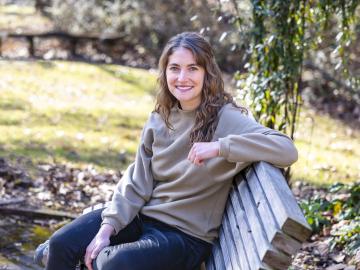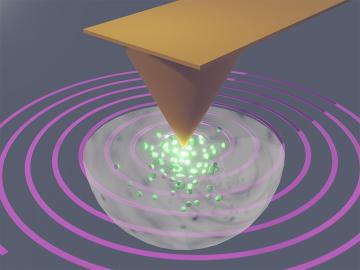Filter News
Area of Research
- Advanced Manufacturing (16)
- Biological Systems (2)
- Biology and Environment (76)
- Building Technologies (7)
- Chemical and Engineering Materials (1)
- Chemistry and Physics at Interfaces (1)
- Clean Energy (230)
- Climate and Environmental Systems (4)
- Computational Biology (1)
- Computational Engineering (2)
- Computer Science (10)
- Data (1)
- Electricity and Smart Grid (1)
- Energy Frontier Research Centers (1)
- Energy Sciences (2)
- Fossil Energy (1)
- Functional Materials for Energy (1)
- Fusion and Fission (11)
- Fusion Energy (8)
- Isotope Development and Production (2)
- Isotopes (14)
- Materials (109)
- Materials for Computing (10)
- Materials Synthesis from Atoms to Systems (1)
- Materials Under Extremes (1)
- Mathematics (1)
- National Security (24)
- Neutron Data Analysis and Visualization (2)
- Neutron Science (43)
- Nuclear Science and Technology (23)
- Nuclear Systems Modeling, Simulation and Validation (2)
- Quantum information Science (3)
- Renewable Energy (3)
- Sensors and Controls (3)
- Supercomputing (50)
- Transportation Systems (2)
News Type
Date
News Topics
- 3-D Printing/Advanced Manufacturing (43)
- Advanced Reactors (15)
- Artificial Intelligence (17)
- Big Data (22)
- Bioenergy (32)
- Biology (38)
- Biomedical (19)
- Biotechnology (7)
- Buildings (28)
- Chemical Sciences (18)
- Clean Water (19)
- Climate Change (37)
- Composites (11)
- Computer Science (52)
- Coronavirus (17)
- Critical Materials (13)
- Cybersecurity (9)
- Decarbonization (23)
- Energy Storage (45)
- Environment (80)
- Exascale Computing (4)
- Frontier (4)
- Fusion (16)
- Grid (27)
- High-Performance Computing (20)
- Hydropower (8)
- Irradiation (2)
- Isotopes (15)
- ITER (4)
- Machine Learning (15)
- Materials (42)
- Materials Science (45)
- Mathematics (5)
- Mercury (7)
- Microscopy (20)
- Molten Salt (5)
- Nanotechnology (18)
- National Security (18)
- Net Zero (3)
- Neutron Science (35)
- Nuclear Energy (33)
- Partnerships (1)
- Physics (20)
- Polymers (14)
- Quantum Computing (5)
- Quantum Science (12)
- Security (7)
- Simulation (11)
- Space Exploration (10)
- Statistics (1)
- Summit (8)
- Sustainable Energy (57)
- Transportation (47)
Media Contacts

Canan Karakaya, a R&D Staff member in the Chemical Process Scale-Up group at ORNL, was inspired to become a chemical engineer after she experienced a magical transformation that turned ammonia gas into ammonium nitrate, turning a liquid into white flakes gently floating through the air.

A team of researchers at ORNL demonstrated that a light-duty passenger electric vehicle can be wirelessly charged at 100-kW with 96% efficiency using polyphase electromagnetic coupling coils with rotating magnetic fields.

Cushman, a Liane B. Russell Fellow at ORNL, has been studying trees and forests in an effort to help humans care for them and improve the health of the planet. Cushman’s fellowship research at ORNL aligns with that, utilizing ground, air and space platforms to study trees and forests in the Southeast.

Although he built his career around buildings, Fengqi “Frank” Li likes to break down walls. Li was trained as an architect, but he doesn’t box himself in. Currently he is working as a computational developer at ORNL. But Li considers himself a designer. To him, that’s less a box than a plane – a landscape scattered with ideas, like destinations on a map that can be connected in different ways.

To capitalize on AI and researcher strengths, scientists developed a human-AI collaboration recommender system for improved experimentation performance.

Chelsea Chen, a polymer physicist at ORNL, is studying ion transport in solid electrolytes that could help electric vehicle battery charges last longer.

Research led by ORNL’s Marti Checa and Liam Collins has pioneered a groundbreaking approach described in the journal Nature Communications that enables visualizing charge motion at the nanometer level, or one billionth of a meter, but at speeds thousands of times faster than conventional methods.

ORNL climate modeling expertise contributed to a project that assessed global emissions of ammonia from croplands now and in a warmer future, while also identifying solutions tuned to local growing conditions.

Ilenne Del Valle is merging her expertise in synthetic biology and environmental science to develop new technologies to help scientists better understand and engineer ecosystems for climate resilience.

ORNL researchers have developed a novel way to encapsulate salt hydrate phase-change materials within polymer fibers through a coaxial pulling process. The discovery could lead to the widespread use of the low-carbon materials as a source of insulation for a building’s envelope.




